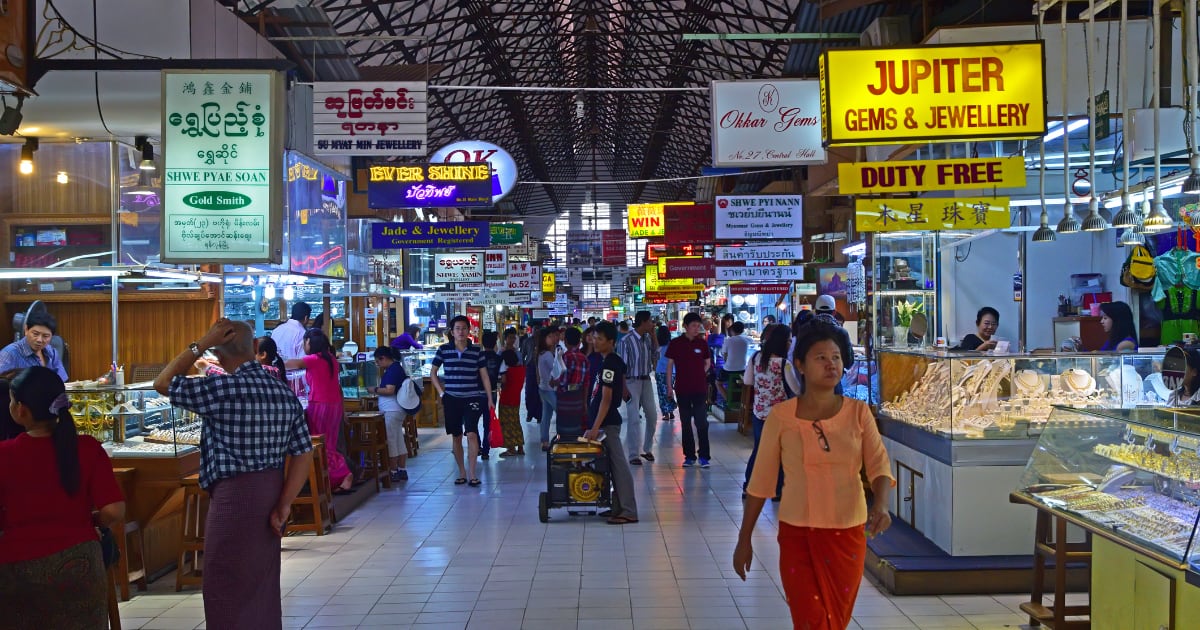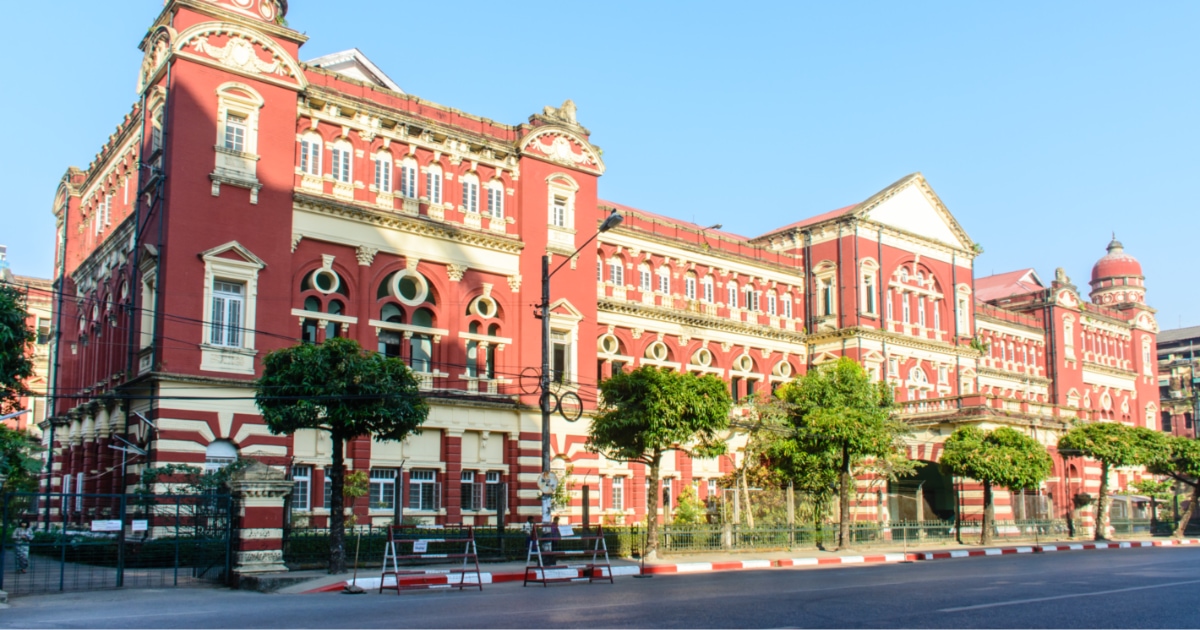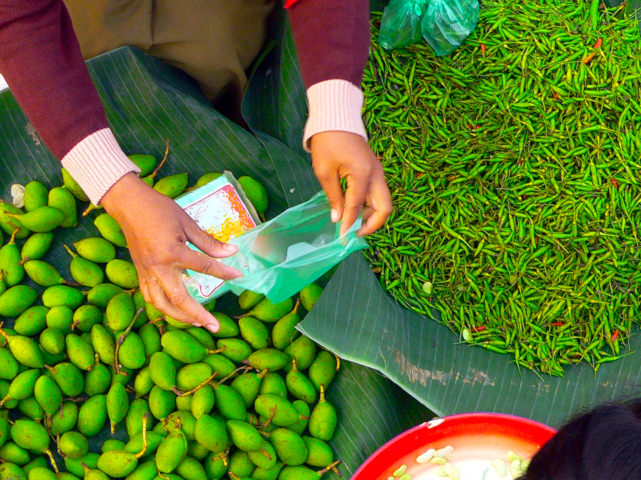
This followed on from the Chamber’s recent webinar at which Julia spoke on the impact of COVID-19 on labour-intensive industries in Myanmar.
Overview of Myanmar’s Economy
According to the World Bank’s latest report in June 2020 on the impact of the pandemic on developing economies in East Asia and the Pacific, Myanmar has been hit hard with economic growth for the 2019/2020 financial year expected to show a sharp decline 0.5%. This is due primarily to the country’s exposure to the global slowdown triggered by the pandemic, and reduced growth in China in particular, since China accounts for 33% of Myanmar’s exports. Restrictions on travel and cross border trade have impacted Myanmar’s tourism industry and related services and its agricultural exports which make up half of Myanmar’s total exports or 4% of GDP. Supply chains have been also been disrupted, particularly in the garment industry which accounts for 13% of the country’s exports.
The labour market has also been affected. Around 78% of Myanmar’s rural work force is employed in agriculture while around 27% of the urban work force works in tourism and related services, areas which have been significantly affected by COVID-19
However, prospects are less bleak than in many developed economies and the World Bank is expecting Myanmar’s economic growth to recover to 7.2% in 2020-2021 and to return to trend in the medium term supported by investment in infrastructure, power and property markets, strong exports and resilient domestic consumption which accounts for 50% of GDP. In fact, the World Bank predict that Myanmar will in the 10% of world economies not to go into recession.
Other positives worth highlighting include:
- travel infrastructure projects which are in progress, facilitated by a new Project Bank; and
- the boost to the service sector provided by the licensing of foreign insurers to operate in Myanmar and allowing foreign banks to provide wholesale and retail lending in the country.
Nevertheless, as elsewhere, the impact of COVID-19 is expected to disproportionately hurt the poor. 68% of Myanmar’s poor work in agriculture and are vulnerable given reduced output and prices due to declines in exports to China.
Household incomes are also likely to be affected by redundancies in the manufacturing sector which employs 500,000 people. High inflation (predicted to moderate to 7.5% in 2019/2020) and potentially higher food prices are also likely to disproportionately hit the poorest sectors of the population.
- Update on Labour-Intensive Industries in Myanmar amid COVID-19
- Factory Reopenings Most companies, shops and restaurants in Yangon, Mandalay and Naypyitaw resumed operations on 1 June 2020, after 2 weeks of no new local transmissions. Bus companies have also been allowed to resume operations if they implement guidelines on COVID-19 preventative measures and Government employees returned to their offices on 1 June 2020 after being required to stay home since 25 March 2020.[1]
However, other regions reopened earlier: around 175 workshops and factories in the Sagaing Region reopened in mid-May[2] and over a thousand factories employing some 20,000 workers in the Magwe region reopened at the end of May after the regional government’s conduct of inspections.[3]
As of 13 June, 2 weeks after major business in Myanmar reopened, Myanmar reported 25 new COVID-19 cases, including 2 locally transmitted cases, bringing the official total to 261. As elsewhere, Myanmar businesses are resuming operations out of economic necessity.[4]
The impact of COVID-19 on Myanmar’s economy is evident in the fall in Myanmar’s Manufacturing PMI to 29 in April 2020, its lowest level since the index began in December 2015 and down from 45.3 in March.[5] However, the latest figures show an increase in the PMI to 48.7 in June 2020, which is being taken as a sign that the most extreme phase of disruption to Myanmar’s manufacturing sector has passed with output and new orders rising for the first time in 4 months.[6]
However, workers are bearing the brunt of measures to reopen the economy with reports of insufficiently ventilated work places and employers failing to provide hand washing facilities.[7] Local press reports point to failings in corporate conduct, hostility to trade unions which would enable workers to obtain greater protection, and perceived failings in the social security system. There are reports of employers not paying wages or paying salaries which leave employees struggling to meet basic living costs.[8]
A number of global brands (including H&M, Inditex and Next) are backing an initiative to implement health and safety protection measures for workers in Myanmar garment factories under a framework for action in collaboration with the Industrial Workers Federation of Myanmar. The initiative aims to benefit 100,000 garment workers and will also work with relevant organisations to fund compensation of workers’ wages lost between April and July.[9]
- Employee Benefits Myanmar established a Social Security Fund in 2012 which was intended to provide a safety net for workers during times of crisis. While the government cannot be blamed for not anticipating the economic crisis triggered by COVID-19, the fund has proved inadequate to protect Myanmar’s factory workers. The Government pledged to pay contributing workers 40% of their salaries if factories closed. In practice, many factory workers are not registered, sometimes because they do not have social security numbers or their employers have not paid their contributions.[10] Many factory workers have apparently received nothing as a result.
Another problem is that despite a pledge by the Central Committee on Prevention, Control and Treatment of COVID-19 to provide food to those with irregular income, factory workers, including those who were dismissed, are not included in the definition of people with irregular income.[11]
- Loans In late March, the Government launched various measures to assist businesses, for example a COVID-19 fund for SMEs and textile and tourism businesses to provide loans at a 1% interest rate. Yet only a fraction of companies have received loans (just 726 businesses out of 4,258 which had applied as at 22 May). Total government lending to businesses impacted by COVID-19 stood at 28 billion kyats (around US$20.2m) as of 1 June 2020.[12]
Businesses have faced difficulties in availing themselves of the Government policies. A number of businesses report being denied access to programmes or finding the application procedures too difficult. Most businesses have not benefitted from the relief measures.[13]
These problems suggest that the Government could take steps to increase awareness of relief measures, simplify the application process, and train staff to ensure policies and schemes are made available in a transparent and consistent manner.[14]
- InvestmentDespite the pandemic, investment into Myanmar has continued. Since the first cases of COVID-19 were identified in Myanmar in March, approval for the investment of around US$8 million in total has been granted to 3 companies based in China and Hong Kong and to one Myanmar company. The investments will be made in Yangon and are expected to be operational within a year and to create around 656 new jobs.[15]
There has been strong foreign investor interest in Myanmar’s garment manufacturing sector despite a significant drop in garment export volumes to US$2.7 billion between 1 October 2019 and 31 May 2020, a US$24 million fall compared to the same period in the previous year.[16]
Hong Kong provided 32% of approved FDI into Myanmar in the first seven months of the 2019/20 fiscal year. Approved Hong Kong investments include investments in electricity and power, garment manufacturing and property development. Commentators have noted that FDI commitments to Myanmar should rise as the country’s energy, infrastructure and manufacturing requirements expand to meet higher demand.[17]
Hong Kong investors are attracted to Myanmar’s garment industry by trade privileges, particularly a 12.5% tax break on Myanmar finished garments exported to European Markets (under the EU Generalised Scheme of Preferences (GSP) Trade programme).[18]
China is a major investor in Myanmar with FDI of US$ 21 billion as of March 2020.[19] Belt and Road Initiative (BRI) projects in Myanmar include the China-Myanmar Economic Corridor project which will connect the Indian Ocean oil trade to China’s Yunnan Province addressing vulnerabilities in China’s oil supply.[20] Discussions are also in progress on developing China’s other Myanmar projects in the context of Myanmar’s COVID-19 Economic Relief Plan (including the New Yangon City, the Kyaukphyu Deep-Sea Port and Industrial Zone and the China-Myanmar Cross-Border Economic Zone Cooperation Zone projects).[21]
It is also interesting to mention that further to Goal 2 of the COVID-19 Economic Relief Plan (CERP) (“reducing the impact on the private sector by promoting investments, trade and banking enterprises), the Government issued a Union Taxation law Ordinance on 12 June 2020, providing a number of tax exemptions to take effect for the 2020-21 tax year. The four main exemptions include:
- non-refundable tax credit on 10% of total additional wages and salaries paid in the 2019-2020 Income Year;
- Deduction from income, classified as expenditure, equivalent to 125% of total additional wages and salaries paid in the 2019-2020 Income Year as compared against the 2018-2019 Income Year;
- Non-refundable tax credit equal to 10% of the total value of additional capital equipment inputs made in the 2019-2020 Income Year (which is not available to businesses already subject to tax exemptions or relief under the Myanmar Investment Law or Special Economic Zone Law); and
- One-time depreciation on the value of capital equipment equivalent to 125% of the usual reduction value for the 2019-2020 Income Year.
The exemptions should go some way in promoting continued investment and trade for companies that are facing financial difficulties.[22]
It is also worth noting that Myanmar’s Ministry of Investment and Foreign Economic Relations (MIFER) finished their second Investment Policy Review (IPR) at the end of June (with it set to be published in the next three months). The review focused on identifying investment policies that need to be improved in order to attract more investment.[23]
- Cross Border and Regional Trade COVID-19 has significantly impacted Myanmar’s cross border trade with trade with China dropping by US$160 mln in the first 8 months of this fiscal year compared to the same period last fiscal year. US$2 bn worth of goods were imported into Myanmar between 30 October 2019 and 15 May 2020.[24]
Myanmar and China have been discussing the negative impact of border restrictions on Myanmar’s seafood and fruit industries.[25] The Myanmar Government is keen to accelerate the flow of perishable goods across the border to reduce exporters’ losses. Myanmar and Beijing have also been working to speed up the provision of Myanmar exports to Chinese customers.[26]
As for regional trade, ASEAN leaders agreed to implement a coordinated response to mitigating the economic impact of COVID-19 at a meeting on 4 June 2020 through facilitating import and export processes in the region and strengthening regional supply chains to maintain the flow of goods and services.[27]
Malaysia, Indonesia and the Philippines have offered to buy rice produced in Myanmar.[28] ASEAN countries increasing their rice stocks also offers Myanmar an opportunity to negotiate long-term export contracts with its neighbours.[29] Myanmar expects to export around 2.5 million tonnes of rice in the 2019/20 fiscal year and has seen exports of 1.8 million tonnes (up to 15 May) earning more than US$542m.[30]
- External Financial SupportThe Japan International Cooperation Agency (JICA) announced emergency loans worth 5 bln yen (US$45.75m) on 1 June to assist businesses in Myanmar impacted by COVID-19. The loans are low-interest loans with 1 to 5 year maturities to support SMEs’ continuing operations. Loans will be provided by Myanma Economic Bank and other commercial banks for working capital and fixed asset investments.[31]
The IMF approved US$356 million of emergency assistance on 26 June 2020 which had been requested by Myanmar to assist it in minimising the impact of COVID-19 by stimulating the economy, and to support spending on health and social safety. The assistance is being provided under the IMF’s rapid credit facility and rapid financing instrument program.[32]
Initial estimates of Myanmar’s budget deficit predicted a deficit 6,555 bn Kyats, although that figure is now expected to grow by 2,000 – 3,000 bn Kyats due to decline in gdp growth in the upcoming fiscal year.[33]
On 27 May, Myanmar’s Parliament approved borrowing 1.3 trillion Kyats (US$925m) from the Central Bank of Myanmar to cover budget deficits. This is expected to fund around 20% of the total deficit.[34]
- E-commerce Myanmar’s Ministry of Commerce announced in May that it will launch a central e-commerce website to promote the use of digital platforms to promote economic growth. The e-commerce website will allow businesses to sell products online and is expected to be launched by the end of 2020. All payments on the website will be made by bank transfers, mobile payments or card payments.[35] Myanmar’s CERP also commits to promoting digital and mobile platforms for payments and retail trade.
- Business Environment and Tourism Around two thirds of Myanmar businesses are facing cash flow problems and struggling to survive.
In early June, Myanmar’s Hotel and Tourism Ministry said that it expected Myanmar’s tourism sector to reopen once it begins implementing stage 3 of the ministry’s strategic roadmap for reopening.[36] However, some tourist locations have reopened for domestic tourism.[37] Hotels in South Shan State have been given the go ahead to receive visitors by regional tourism authorities after implementing COVID-19 preventative measures (with 34 out of 58 hotels in Kalaw back to normal operations). Kayah state has also reopened for domestic tourists except visitors from two Yangon townships with high COVID-19 rates.[38]
As of 1 June, the Government had lent 7 bn Kyats to 168 hotels, over 1 bln Kyats to tourism-related businesses, and 1bn+ Kyats to 58 restaurants.[39] Come July, the overall figure had risen to more than 21 billion Kyats (or $15.5 million US Dollars).[40]
- Factory Reopenings Most companies, shops and restaurants in Yangon, Mandalay and Naypyitaw resumed operations on 1 June 2020, after 2 weeks of no new local transmissions. Bus companies have also been allowed to resume operations if they implement guidelines on COVID-19 preventative measures and Government employees returned to their offices on 1 June 2020 after being required to stay home since 25 March 2020.[1]
- Myanmar’s New Insolvency Law Myanmar has recently modernised its insolvency regime with the implementation of a unified Insolvency Law 2020 which covers personal and corporate insolvency and cross-border insolvency. The new law came into effect on 25 March 2020 except for Part X on cross-border insolvency which will come into effect on a date to be notified. The Insolvency Rules 2020 supplementing the new law were published on 28 April 2020. The new law repeals the Yangon Insolvency Act 1909 and the Myanmar Insolvency Act 1920 and also overrides the provisions on company winding-up included in the Myanmar Companies Law 2017.
Developed in partnership with the Asian Development Bank (ADB), key aspects of the new Insolvency Law are:
- the introduction of a corporate rescue and rehabilitation process as an alternative to liquidation;
- provisions allowing individuals facing insolvency to enter into voluntary arrangements with their creditors, providing for part of the debt to be written off or for payments over a fixed period, usually with no interest; and
- although not yet in force, the adoption of the United Nations Commission on International Trade Law’s (UNCITRAL) Model Law on cross-border insolvency for distressed companies that have creditors or assets in more than one jurisdiction. This latter development is likely to be of particular interest to foreign investors in Myanmar.
Given the financial pressures facing companies and small and medium-sized enterprises, in particular, in the wake of the COVID-19 pandemic, the new Insolvency Law is likely to be a welcome development.
- Corporate Rescue and Rehabilitation MechanismThe new law’s corporate rescue and rehabilitation mechanism has been created to cater for Myanmar’s developing economy. It seeks to offer companies facing financial distress an alternative to liquidation and aims to safeguard companies existence as a going concern, or if this cannot be achieved, to rescue as much of their businesses as possible.
The law introduces a 2-stage process. The first is the “rescue stage” during which an insolvency practitioner is appointed as the rehabilitation manager to manage the company and explore the options for the company’s rehabilitation with the company’s creditors. The rehabilitation manager is responsible for preparing the rehabilitation plan to submit for the creditors’ approval. In formulating the plan, the rehabilitation manager must assess its viability and the likely return to creditors and ensure that the company’s associates are not given an advantage over the company’s other creditors.
Protections included in the new Insolvency Law for companies subject to a corporate rescue are that:
- security cannot be enforced against the company without leave of the Court or the rehabilitation manager’s written consent; and
- no proceedings can be brought or continued against the company or its guarantor except with leave of the court.
A creditors’ voluntary winding-up will be implemented if creditors do not agree to implement a rehabilitation plan or terminate a rehabilitation plan, or if a plan is not executed within a specified time frame. The company’s creditors or a court may also resolve to wind up the company.
- MSME Enterprise Rescue and RehabilitationThe new insolvency regime also creates a separate procedure for the rescue and rehabilitation for micro and small to medium enterprises (MSMEs) which are the backbone of the Myanmar economy. Both incorporated and unincorporated MSMEs are eligible for the MSME Rescue and Rehabilitation Plan if their business debts are below MMK 10 million in the case of incorporated MSMEs or below MMK 1 million for unincorporated MSMEs.
The MSME rescue and rehabilitation process is similar to the corporate rescue and rehabilitation process in that it comprises a rescue stage and enterprise plan stage, although the process is simpler and less costly. The MSME rescue package also has the same aims and provides the same protections as the corporate rescue process.
However there are a number of fundamental differences between two, principally that:
- The MSME rescue procedure involves the appointment of a Rehabilitation Adviser – rather than a Rehabilitation Manager. The role of the rehabilitation adviser is to advise the MSME on the business’ rescue. Unlike a Rehabilitation Manager, the Rehabilitation Adviser to an MSME does not manage the business or have control of its assets.
- Whereas the rehabilitation plan for corporate rescue and rehabilitation is prepared by the Rehabilitation Manager or another interested party, in the case of MSMEs, it will be prepared by the MSME or by the rehabilitation adviser with the MSME’s consent; and
During the rescue stage for corporates, all directors’ powers cease unless the Rehabilitation Manager sanctions their exercise. In the case of MSMEs, the powers of the directors, proprietors or partners continue.
- Personal InsolvencyThe new law creates a clearer process for bankruptcy proceedings. A creditor owed MMK 1 million or more can issue a bankruptcy notice against an individual. If the debt is not repaid within 21 days, the creditor can present a petition for bankruptcy to the courts.
- Cross-border insolvencyPart X of the new Insolvency Law adopts the principles of the UNCITRAL Model Law on cross-border insolvency which streamlines the process for representatives in offshore insolvency proceedings to be recognised by, and obtain relief from, the Myanmar courts.
The significance of the adoption of the Model Law is that it should make Myanmar more attractive to foreign investors since it will strengthen cooperation between courts on cross border insolvency matters. In particular, the value of debtors’ assets should be afforded protection.
Looking to the Future of Insolvency Law in Myanmar
The new Insolvency Law is a significant step for Myanmar in enhancing its attractiveness to international investors, developing the market economy and discouraging the use of informal channels for debt recovery.
It is hoped that the rescue and rehabilitation process will enable Myanmar to raise its ranking on the World Bank’s Ease of Doing Business report, one of the criteria for which is the ease of resolving insolvency in terms of the time, cost, outcome and recovery rate for commercial insolvency and the strength of the legal framework. In the 2020 Report, Myanmar ranked 165th out of 190, rising 6 places from 2019.
Further focus on capacity building is likely to be necessary given the lack of experienced insolvency practitioners, and the Government’s commitment to continued commercial law reform.
Comparison: India and Pakistan
Prior to the pandemic, India was already seeing a surge in insolvency cases (increasing by 30.3% between October to December 2019 by 123% for 2019 as a whole, with a total of 3,312 companies admitted for insolvency resolution). Of those, 1,343 were manufacturing companies, which is particularly interesting given that the government has been offering more policy support to the sector.
In light of the impacts of COVID, and in addition to economic measures announced by the Ministry of Finance to support Indian businesses, the Insolvency and Bankruptcy (Amendment) Ordinance was promulgated on 5 June 2020, which introduced a number of amendments to the Insolvency and Bankruptcy Code 2016 (the IBC), which took immediate effect in order to provide some breathing space for Indian businesses hit by the pandemic. Notable amendments include:
- Restriction on the filing of any application for initiation of the corporate insolvency resolution process of a corporate debtor for any default after 25 March 2020 for a period of 6 months (or longer subject to further notifications); and
- Insertion of a non-obstante clause to give protection to directors of a corporate debtor.
In terms of the implications of the amendments, it would seem that the out-of-court restructuring regime under the Prudential Framework for Resolution of Stressed Assets (2019) will come into focus, and where restructuring is unfeasible for companies, the lenders would have to rely on applicable recovery and enforcement tools. The winding-up procedure under the Companies Act and Voluntary liquidation under the IBC continues to be available.
Pakistan:
Turning now to Pakistan. As according to the Pakistan Economic survey, Pakistan’s debt is set to rise to 88% of GDP and I’ll share a couple of on the ground examples of difficulties faced.
For example, Pakistan International Airlines stated that losses and debt have become too much for the company to handle alone (with accumulated losses of $3 billion US dollars at the end of last year) and suggested to that the Government should include a debt-to-equity swap and long-term bond issue.
Meanwhile, the University of Engineering and Technology went bankrupt in early July with the University Vice Chancellor stating that they informed the Government numerous times of the condition of the University’s finances but nothing was done. This follows the Pakistan Government’s move to cut higher education funding by 19% in the 2019/2020 budget, which in the words of a Pakistani academic is indicative of the funding for higher education going from “boom (in 2002-2008) to bust”.[41]
- Industrial Zone Law
- Overview of the Enactment of the Industrial Zone Law and the Industrial Sector in Myanmar The Industrial Zone Law was enacted on 26 May 2020 with the aim of promoting industrialisation, creating job opportunities, attracting foreign investment and increasing the number of products manufactured with domestic raw materials.
This is Myanmar’s first law on industrial zones and seeks to realise the Government’s goal of increasing the industrial sector’s contribution to GDP to 37% by 2030/2031. In 2018, industrials accounted for 32% of GDP and 18% of employment.[42] Industrials are expected to contribute 33% to GDP in 2020/2021,[43] and the World Bank expects overall industrial growth to reach 9.6% in the 2018/2019 financial year and 9.5% in the 2019/2020 financial year, due to an expected increase in manufacturing and construction activity.[44]
Looking briefly at Myanmar’s manufacturing sector which accounted for around three-quarters of the industrial sector in 2018/2019, manufacturing output grew from 10% in 2017/2018 to 10.2% in the 2018/2019 financial year, and was the third largest sector in terms of FDI value (behind oil and gas and power).[45] The sector has however been adversely impacted by the Kyat’s depreciation and inflation in recent years, although a shift towards higher-value-added production has been driving growth.[46] Although of course right now the Kyat is strengthening.
Comparatively, Myanmar relies heavily on agriculture, with the sector providing 49% of employment (78% in rural areas). The World Bank predicts that agricultural sector growth should average 4.6% in the medium term.[47] Agriculture’s contribution to GDP reduced from 40% in 2010-2011 to 26% in 2018-2019 (estimated to be 24% as of 2020-2021)[48] but right now of course, it is a relatively bright spot in Myanmar’s economy.
- Development of Myanmar’s Industrial Sector
Sector Growth
Myanmar’s industrial sector includes mining, energy, manufacturing and processing, electric power and construction and industry. It has benefitted from a period of strong economic growth and an increasingly welcoming environment for foreign investment and regulatory reforms.[49] The growth in Myanmar’s industrial sector can be attributed to low labour costs (with a minimum wage of around US$3 per day, among the lowest in the region), rising domestic demand and economic zone incentives.[50]
An important point to note is the pressure Myanmar industry faces from rising electricity costs, following a Government hike in electricity tariffs, the first in 5 years. This has been felt directly by, for example, auto component traders, with reports that prices have risen 40% and overall costs by 5 to 7%. Despite this, the industrials sector has indicated preparedness to absorb higher rates, given Myanmar’s energy challenges (for example, an unreliable power supply, which is not conducive to advanced manufacturing) and the need for change, particularly if this results in a more stable provision of service.[51]
Industrial Zone Development and SEZs
In 1995, the Myanmar Government formed the Myanmar Industrial Development Committee (MIDC) which established 18 industrial zones in 9 states and regions. The MIDC was later renamed the Industrial Development Committee (IDC)[52] and its primary role was promoting green and clean industries in collaboration with Myanmar’s Chamber of Commerce and Industry and government committees with responsibility for the industrial zones.
Today, there are some 60 industrial zones in Myanmar, 29 of which are in Yangon. There are also a number of Special Economic Zones (SEZs) which are under development in the Rakhine State, Thanintharyi Region and in the Yangon Region). SEZs are governed by the Special Economic Zone Law, enacted in 2011.
The Yangon Regional Government is working to upgrade its industrial zones given the lack of infrastructure which has resulted in low levels of economic zone activity. The industrial zones outside Yangon also face difficulties in terms of poor transport links to highways and railroads and with many zones developed in the 1990s and 2000s, many have struggled to attract investment. Zones in the Ayeyarwady Region are however close to sea ports, and the Government has indicated its intention to expand the number of zones in this region.[53]
Myanmar’s SEZs, on the other hand, have secured significant institutional and financial support for development. In the 10 months to July 2019, Myanmar’s SEZs attracted US$1.72 billion in FDI (of which Singapore was the largest contributor, accounting for 37.5% of overall investment).[54]
The Thilawa SEZ is perhaps the most successful SEZ, and currently employs around 10,000 people and has attracted over US$1.6 billion in approved investment. As of mid-2019, more than half of the zone’s developed area was occupied (having attracted over 100 companies, 90 of which are foreign owned, the majority of which are Japanese).[55] Looking forward, the zone is pressing ahead with further development plans and aims to open a further 500,000 square metres in 2020.[56]
Thilawa SEZ’s success is attributable to its good transport links: the zone has its own river port and benefits from the Bago River Bridge. This is not to say that the zone does not face challenges, and high labour turnover has been a problem.
The regional government also plans to create new industrial zones and has formed an industrial zone management committee to verify whether companies granted land are actually utilising it, with the committee prepared to reclaim land that is not in use. This contrasts with the previous approach when land utilisation requirements were often not enforced. As of September 2019, 40% of industrial zone plots in Yangon were undeveloped.[57]
- The New Industrial Zone law The new Industrial Zone law aims to facilitate growth in Myanmar’s industrial sector, establish consistent rules and regulations for industrial zones, create employment and improve economic growth and living standards.
Definition of Industrial Zone and Monitoring of Industrial Zones
An “industrial zone” is land designated as an industrial zone by a Government notice. All new and existing zones will be monitored by the Regional Industrial Zones Development and Management Committee (the Regional Committee) which will also be responsible for submitting investment proposals, policies, industrial development programmes, and reports to the Industries and Industrial Zone Development Central Committee (the Central Committee) for approval.
Establishing Industrial Zones
A developer wanting to establish an industrial zone is required to submit an investment proposal to the Regional Committee which must comply with the following breakdown of land use:
Industrial Area 60% to 70% Commercial Area 1% to 5% Public Utilities and Assistant Area 20% to 25% Green Belt 9% to 10%.[58] The Regional Committee will then submit a proposal specifying the size, type and level of industrial zone for approval by the Central Committee.[59]
Once an agreement has been entered into between the developer and the Regional Committee, the developer can establish an industrial zone business, sub-lease the land to investors and build infrastructure.[60]
Developers must complete the work for each construction project within the industrial zone within the specified period. If there is no compelling reason for failing to accomplish the work, the permit will be revoked.[61]
Developers must comply with all relevant laws on environmental conservation, workplace safety, health care and fire safety.[62]
Matters relating to the Bonded Warehouse System within an industrial zone must be carried out in accordance with Myanmar customs law and procedures.[63]
Permitted Activities in Industrial Zones
The new Investment Zone law allows the following activities to be conducted in an industrial zone:
- manufacturing finished products, related products, packaging products and value-added products;
- transporting and delivering raw materials and finished products,
- business relating to road maintenance and road upgrade; and
- trading of manufactured products.[64]
Much like the conditions imposed on developers, investors must complete work on construction projects within the specified period and failure to do so without a sufficiently compelling reason may result in revocation of the permit.[65]
Land Use Rights
Developers and investors can use industrial land for industrial, manufacturing or related businesses for up to 50 years with the possibility of two 10 year extensions with the approval of the Regional Committee.[66] Projects that are not completed within the specified project period are subject to a fine equivalent to 10% of the land value and if payment of the fine is not possible, the land use permit or grant will be revoked.[67]
Incentives for Industrial Zones
Developers and investors are entitled to an exemption from income tax for specified periods depending on the zone’s location.
The Central Committee may also provide special incentive periods for the following investment activities (through the issue of notifications):
- the establishment of industrial zones in less developed regions and investments therein;
- investments which create many job opportunities in regions with low employment rates;
- investments which are capable of exporting agricultural primary products as valued-added products;
- investments which manufacture certain agricultural machines and equipment; and
- export business of valued-added products and manufacture of innovative products.[68]
- Further Developments Relevant to the Industrial Sector The primary aim of the new Industrial Zone Law is to promote economic growth and develop Myanmar’s industrial sector. There are however other developments relevant to the development of the industrial sector.
Regulatory Developments
- In November 2019, the Myanmar Parliament voted in favour of merging the Ministry of Industry and Ministry of Planning and Finance to create a single government body dedicated to supporting the reform of state-owned enterprises through private investment.
- In August 2018, the Myanmar Companies law came into force allowing foreigners to own 35% of a Myanmar company.
- From 20 March 2020, foreign investors have been allowed to trade companies listed on the Yangon Stock Exchange
Promotion of Investment
In November 2018, the Government launched the Project Bank prioritising projects in need of funding and making them available for a review on a transparent online database.
The initiative aims, among other things, to improve the allocation of development finance and private investment and promote public-private partnerships. Investment in the government’s priority sectors are eligible for incentives such as exemption from corporate income tax (for up to 7 years), exemption from customs duties on non-domestically available materials and 50-year land leases (which may be extended twice for 10 years). Promoted sectors include manufacturing, establishment of industrial zones, infrastructure and renewables.
Transport Developments
Transport developments also have the potential to improve Myanmar’s appeal for industrial investment owing to the logistical benefits. Transport developments include, India’s Adani Yangon Internal Terminal securing DICA approval in May 2019 to construct a US$ 290 million port to handle an additional 800,000 twenty-foot equivalent unit containers.[69]
The Ministry of Transport and Communications has also been collaborating with the JICA to create a national logistics master plan (NLMP) to develop infrastructure capable of handling an expected 85% increase in cargo movements by 2030. The NLMP will include 167 project proposals designed to create an efficient logistics system encouraging foreign investment and unlocking industrial and agricultural development.[70]
Foreign Partnerships
It is expected that foreign partnership will facilitate further investment in Myanmar industries. Current examples include:
- South Korea laying the groundwork for companies to invest more heavily in Myanmar;
- Myanmar’s Urban and Housing Development Department signing a joint venture with Korea Land and Housing Corporation in August 2019 to develop the Korea-Myanmar Industrial Complex around 10 km north of Yangon;
- The China-Myanmar Economic Corridor which is being developed as part of China’s BRI;
- The Muse Economic Zone;
- The 2018 agreement with China for a deep-sea port and SEZ in Rakhine State;
- The US$ 400 million economic free zone on the outskirts of the capital of Kachin State, which is earmarked for development by China’s Yunnan Tengchong Hengyong Investment, with a follow up agreement set to be signed in 2020;
- The nine-point agreement entered into between Myanmar and Thailand in October 2019 for the US$ 8 billion Dawei SEZ, set to be Southeast Asia’s largest industrial complex; and
- The signing of a framework agreement between the Ministry of Construction and Thailand’s Amata Corporation in August 2019 to jointly develop a US$1billion smart eco city in Yangon – set to be the first industrial zone between Myanmar and Thailand.[71]
Comparison: Pakistan and India
India:
The Indian Government has long used Export Processing Zones (EPZs) to promote exports, with the first EPZ in Asia established in 1965 in Kandla. EPZs had a broadly similar structure to SEZs, which began to be established in in the 2000s under the Foreign Trade Policy in order to address challenges that limited the success of EPZs (mainly infrastructure-related and bureaucratic challenges) and are closely based on China’s successful SEZ model.
The Special Economic Zone Act of 2005 then amended India’s SEZ policy and saw many EPZs converted to SEZs and the acceptance of proposals for smaller SEZs, with to date at least 232 in operation and 351 notified under the SEZ Act.
In terms of the impact of COVID on India’s SEZs, the Indian Government has taken action to mitigate negative effects for example by announcing relaxations in filing compliance reports for units and developers of SEZs, suspension of punitive action against companies or developers operating in SEZs where compliance is not met, and extensions of Letters of Approval in specified circumstances (such as for units yet to commence operations).
Despite the impacts of COVID, the outlook for India’s SEZs does not appear to be too bleak, and in fact it may be good news for Indian competitiveness and capital inflows owing to multinational companies looking for cheaper alternatives to meet their manufacturing needs. With India’s SEZs offering competitive infrastructure, duty free exports and tax incentives to name but a few, foreign firms may increasingly be looking to India.
Pakistan:
As for Pakistan, the situation is quite different. As mentioned, the economy is in a far from ideal state and so Pakistan is eager to replicate China’s economically successful SEZ model, with 9 official SEZs (and 1 Free Economic Zone) to be constructed under the China-Pakistan Economic Corridor (the CPEC), which will provide a lifeline to Pakistan’s industrial development and boost the country’s exports, with estimates that exports could be increased by 1 to 1.5 billion US dollars annually.[72]
As for investors, the overall aim appears to be to attract both domestic and foreign investors through a series of preferential policies, which will in turn kick-start the economy and China will be a prominent investor, reportedly set to invest $5 billion US dollars over the course of the next three to five years.[73] As according to a public-private partnership investing in Punjab province’s SEZ (the Allama Iqbal Industrial City or AIIC) investors from Turkey and the UK have also shown interest.[74]
- Overview of the Enactment of the Industrial Zone Law and the Industrial Sector in Myanmar The Industrial Zone Law was enacted on 26 May 2020 with the aim of promoting industrialisation, creating job opportunities, attracting foreign investment and increasing the number of products manufactured with domestic raw materials.
[1] https://www.irrawaddy.com/specials/myanmar-covid-19/myanmar-back-work-no-local-covid-19-transmissions-two-weeks.html
[2] https://www.fibre2fashion.com/news/textile-news/myanmar-s-suu-kyi-orders-monitoring-of-factories-for-virus-267157-newsdetails.htm
[3] https://www.mmtimes.com/news/magwe-govt-allows-more-1000-factories-reopen.html
[4] https://www.irrawaddy.com/business/business-roundup/irrawaddy-business-roundup-22.html
[6] Trading Economics Data, 2020. At: https://tradingeconomics.com/myanmar/manufacturing-pmi
[7] https://frontiermyanmar.net/en/factory-workers-suffer-blame-and-pain-in-myanmars-covid-19-response
[8] https://frontiermyanmar.net/en/factory-workers-suffer-blame-and-pain-in-myanmars-covid-19-response
[10] https://frontiermyanmar.net/en/factory-workers-suffer-blame-and-pain-in-myanmars-covid-19-response
[11] https://frontiermyanmar.net/en/factory-workers-suffer-blame-and-pain-in-myanmars-covid-19-response
[12] https://www.irrawaddy.com/specials/myanmar-covid-19/two-thirds-myanmar-businesses-struggle-survive-pandemic-survey%e2%80%a8.html
[13] https://www.irrawaddy.com/specials/myanmar-covid-19/two-thirds-myanmar-businesses-struggle-survive-pandemic-survey%e2%80%a8.html
[14] https://www.irrawaddy.com/specials/myanmar-covid-19/two-thirds-myanmar-businesses-struggle-survive-pandemic-survey%e2%80%a8.html
[15] https://www.mmtimes.com/news/investments-yangon-continue-despite-pandemic.html
[16] https://www.mmtimes.com/news/investor-interest-myanmar-garment-sector-still-strong-despite-lower-exports.html
[17] https://www.mmtimes.com/news/hong-kong-top-fdi-source-myanmar-fiscal-year.html
[18] https://www.irrawaddy.com/business/business-roundup/irrawaddy-business-roundup-22.html
[19] Wilson Centre. The China-Myanmar Economic Corridor and China’s Determination to See It Through https://www.wilsoncenter.org/blog-post/china-myanmar-economic-corridor-and-chinas-determination-see-it-through
[20] https://thediplomat.com/2020/05/is-china-deploying-covid-19-diplomacy-to-speed-bri-projects-in-myanmar/
[21] https://www.irrawaddy.com/business/myanmar-covid-19-recovery-plan-wont-favor-chinas-bri-projects-official-says.html
[22] https://www.tilleke.com/resources/myanmar-announces-covid-19-tax-exemptions
[23] https://www.irrawaddy.com/business/business-roundup/irrawaddy-business-roundup-24.html
[24] https://www.irrawaddy.com/business/business-roundup/irrawaddy-business-roundup-21.html
[25] https://www.irrawaddy.com/business/business-roundup/irrawaddy-business-roundup-21.html
[26] http://www.jvmyanmar.com/wp-content/uploads/2020/05/WHM_MarketValuation-Myanmar-May-2020.pdf
[27] https://www.mmtimes.com/news/myanmar-commits-facilitating-trade-within-asean.html
[28] https://www.mmtimes.com/news/three-asean-countries-offer-buy-myanmar-rice.html
[29] https://www.mmtimes.com/news/three-asean-countries-offer-buy-myanmar-rice.html
[30] https://www.mmtimes.com/news/three-asean-countries-offer-buy-myanmar-rice.html
[31] https://www.irrawaddy.com/business/business-roundup/irrawaddy-business-roundup-21.html
[32] IMF. 26 June 2020. “IMF Executive Board Approves US$356.5 million Disbursement to Myanmar to Address the COVID-19 Pandemic. https://www.imf.org/en/News/Articles/2020/06/26/pr20247-myanmar-imf-executive-board-approves-a-us-356-5m-disbursement-address-covid19
[33] https://www.irrawaddy.com/specials/myanmar-covid-19/myanmar-parliament-approves-700-million-imf-loan-covid-19-spending.html
[34] https://www.irrawaddy.com/specials/myanmar-covid-19/myanmar-parliament-approves-700-million-imf-loan-covid-19-spending.html
[35] https://www.irrawaddy.com/business/business-roundup/irrawaddy-business-roundup-20.html
[36] https://www.irrawaddy.com/business/business-roundup/irrawaddy-business-roundup-22.html
[37] https://www.irrawaddy.com/business/business-roundup/irrawaddy-business-roundup-22.html
[38] https://www.irrawaddy.com/business/business-roundup/irrawaddy-business-roundup-22.html
[39] https://www.irrawaddy.com/business/business-roundup/irrawaddy-business-roundup-21.html
[40] https://www.irrawaddy.com/news/burma/domestic-tourism-reopens-myanmar-businesses-struggle-get-back-feet.html
[41] https://www.timeshighereducation.com/news/pakistan-funding-cuts-disastrous-universities
[42] https://www.pwc.com/mm/en/publications/assets/myanmar-business-guide.pdf
[43] https://www.pwc.com/mm/en/publications/assets/myanmar-business-guide.pdf
[44] Myanmar 2020 Report.
[45] Myanmar 2020 Report.
[46] Myanmar 2020 Report.
[47] World Bank Report 2020 on East Asia and Pacific Economies amid Covid-19.
[48] https://www.pwc.com/mm/en/publications/assets/myanmar-business-guide.pdf
[49] Myanmar 2020 Report.
[50] Myanmar 2020 Report.
[51] Myanmar 2020 Report.
[52] https://www.ide.go.jp/library/English/Publish/Download/Brc/pdf/10_02.pdf
[53] Myanmar 2020 Report.
[54] Myanmar 2020 Report.
[55] Myanmar 2020 Report.
[56] Myanmar 2020 Report.
[57] http://www.xinhuanet.com/english/2019-09/25/c_138422195.htm
[58] Section 15 of the Industrial Zone Law
[59] Section 16 of the Industrial Zone Law
[60] Section 23 (b) of the Industrial Zone Law
[61] Section 23 (d) of the Industrial Zone Law
[62] Section 23 (g) of the Industrial Zone Law
[63] Section 23 (i) of the Industrial Zone Law
[64] Section 24 of the Industrial Zone Law
[65] Section 26 of the Industrial Zone Law
[66] Section 32 of the Industrial Zone Law
[67] Section 34 (b) of the Industrial Zone Law
[68] Section 46 of the Industrial Zone Law
[69] Myanmar 2020 Report.
[70] Myanmar 2020 Report.
[71] Myanmar 2020 Report.
[72] http://www.xinhuanet.com/english/2020-03/17/c_138886649.htm
[73] https://nation.com.pk/23-Mar-2020/pakistan-require-special-economic-policies-to-implement-sezs
[74] http://www.xinhuanet.com/english/2020-03/17/c_138886649.htm
Important Legal Developments amid COVID-19: New Insolvency Law and Industrial Zone Law
Overview of Myanmar’s Economy
Update on Labour-intensive Industries in Myanmar amid COVID-19
Factory Reopenings
Employee Benefits
Loans
Investment
Cross Border and Regional Trade
External Financial Support
E-commerce
Business Environment and Tourism
Myanmar’s New Insolvency Law
Corporate Rescue and Rehabilitation Mechanism
MSME Enterprise Rescue and Rehabilitation
Personal Insolvency
Cross-border Insolvency
Looking to the Future of Insolvency Law in Myanmar
Comparison: India and Pakistan
Industrial Zone Law
Overview of the Enactment of the Industrial Zone Law and the Industrial Sector in Myanmar
Development of Myanmar’s Industrial Sector
The New Industrial Zone Law
Further Developments Relevant to the Industrial Sector
Comparison: Pakistan and India
This newsletter is for information purposes only. Its contents do not constitute legal advice and it should not be regarded as a substitute for detailed advice in individual cases.
Transmission of this information is not intended to create and receipt does not constitute a lawyer-client relationship between Charltons and the user or browser.
Charltons is not responsible for any third party content which can be accessed through the website.
If you do not wish to receive this newsletter please let us know by emailing us at unsubscribe@charltonslaw.com







